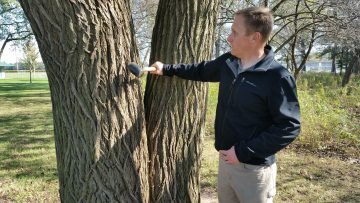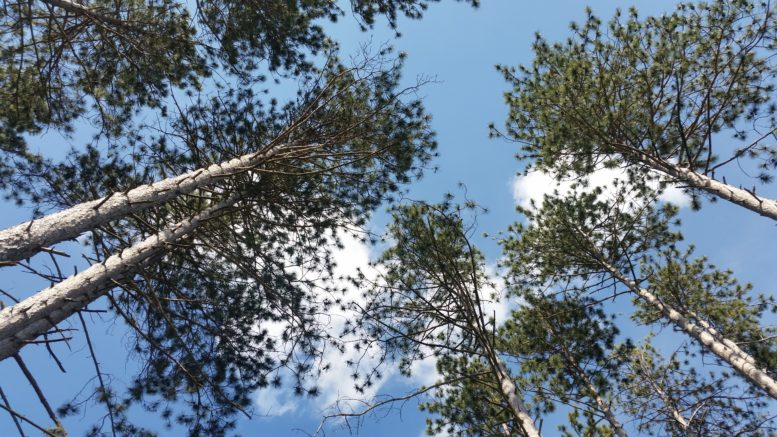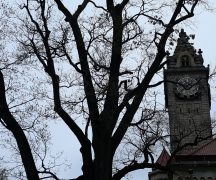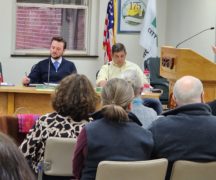By JAN LARSON McLAUGHLIN
BG Independent News
Bowling Green’s tree doctor uses mushrooms, spotted maple leaves and rubber mallets as clues to tree health.
As trees lose their leaves, their bared branches may reveal some health issues that are concealed during the warmer months of the year. So autumn is a good time to give a close look at trees, according to Bowling Green City Arborist Grant Jones.
Jones recently held a tree clinic for local residents in Carter Park, using many of the trees there as examples.
“We talked about the signs of problems now, and down the road,” Jones said.
For example, mushrooms growing close to a tree or even on the branches themselves can be a tell-tale sign of problems, he warned.
“If you see mushrooms around a tree, you want to get that checked out,” he said. “It’s saying there’s some sort of decay in the tree or the roots. It can be a sign of bigger problems.”
It’s not uncommon for trees in the Bowling Green area to lean to the east – as a result of strong west winds in the region. A little lean is survivable, Jones said.
“Leans are OK as long as you don’t start to see the soil heaving,” he said. The best way to prevent slanting trees is to stake them while they are young.
“As long as you see it try to correct itself,” the tree is probably OK, Jones said.
Just as exposed roots can be a problem, so can roots that are buried too deep. A healthy tree should have roots flaring off where the trunk enters the ground. But trees planted too deep resemble a telephone pole, Jones said.
The risk to the tree is “girdling roots,” where the roots wrap around the trunk of the tree and strangle it, he said.

Bowling Green City Arborist Grant Jones uses rubber mallet to check for rotted wood in a Carter Park tree.
Some homeowners start to fret if their trees lose their leaves early. But Jones advised that some trees just naturally shed earlier than others – like the Catalpa and Hawthorne.
Other trees, like Crabapples, are prone to leaf diseases this year. The problem, called “apple scab,” is not deadly and most of the Crabapples will recover just fine.
“A lot of them lost their leaves back in August,” Jones said. “They will leaf out and flower just fine the next year.”
Norway Maples have also struggled this year, with their leaves being dotted with black spots the size of quarters.
“A lot of people were concerned about their Norway Maples,” Jones said.
The arborist advised that owners of those trees rake up the leaves this fall and move them away from the maples in an effort to lessen the problem next year.
As he walked through Carter Park, Jones came upon a Linden tree with several branches jutting out from the same part of the tree. That raises concerns about the branches not being attached strongly.
“If it’s a young tree, you can prune and try to correct it,” he said.
When pruning, Jones warned against “topping” trees. “You always want to cut back to another branch,” he said.
Next he came to a Zelkova tree, with heavy bark between branches that can become wedges of ice or snow in the winter.
Some areas of extra bark and bulges are caused by cavities and decay. “The tree kind of tries to compensate for that,” he said.
Jones carries a simple tool for identifying decay inside a tree. He uses a rubber mallet, the kind that can be purchased at any hardware store, to tap on tree trunks.
“If it sounds a bit like a drum, that can be a sound of decay inside,” he said.
For larger trees on city property, Jones uses a tool nicknamed an EKG, that prints out a strip showing the density of the tree. The instrument uses a 15-inch drill bit about the width of a wire coat hanger. The bit measures the resistance of the wood.
“When the bottom drops out of it,” that means the wood is rotten, Jones said.
Some rot is acceptable, depending where it is, he added. “Is there enough rot that a tree is going to have stability issues? Does the tree have enough good wood to support the tree?”
Bowling Green residents with concerns about their trees may call Jones at 419-353-4101.





